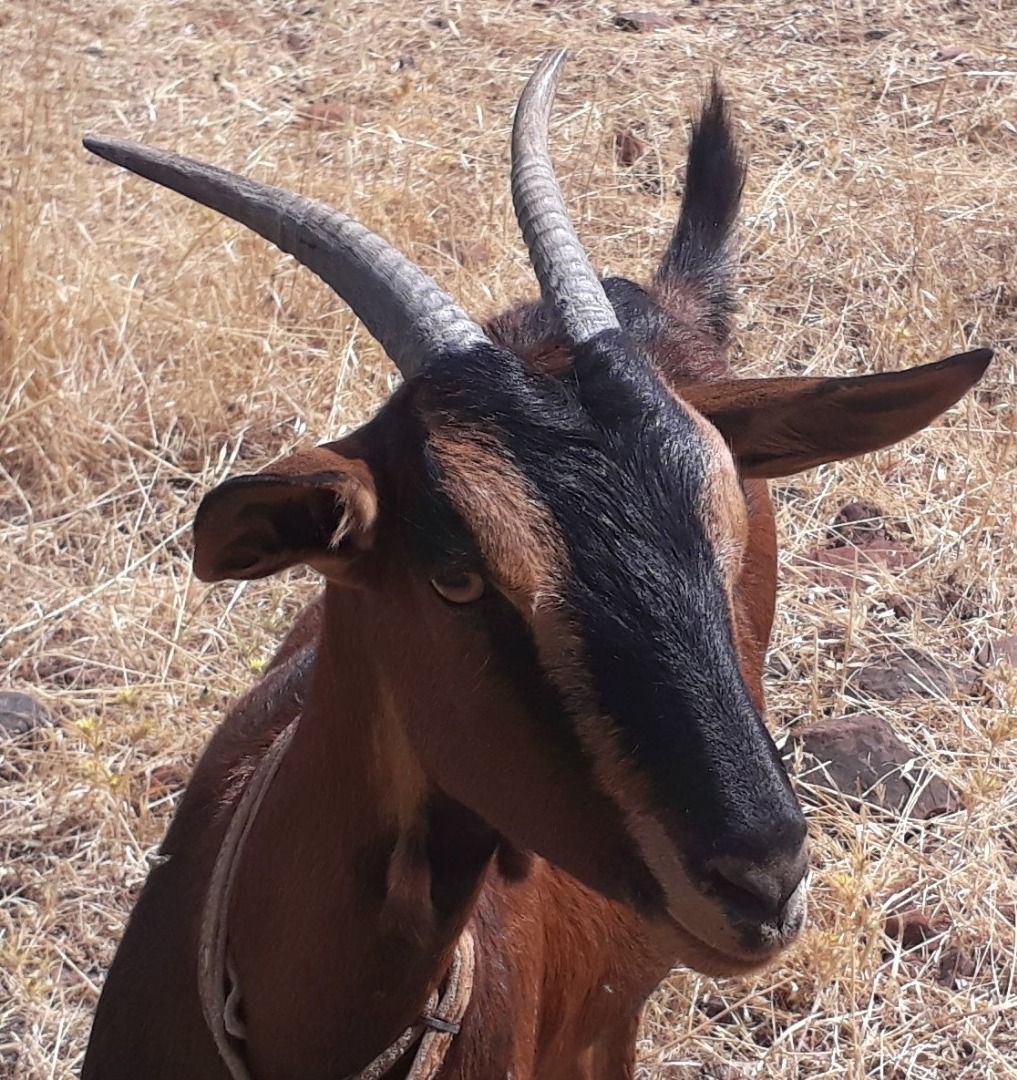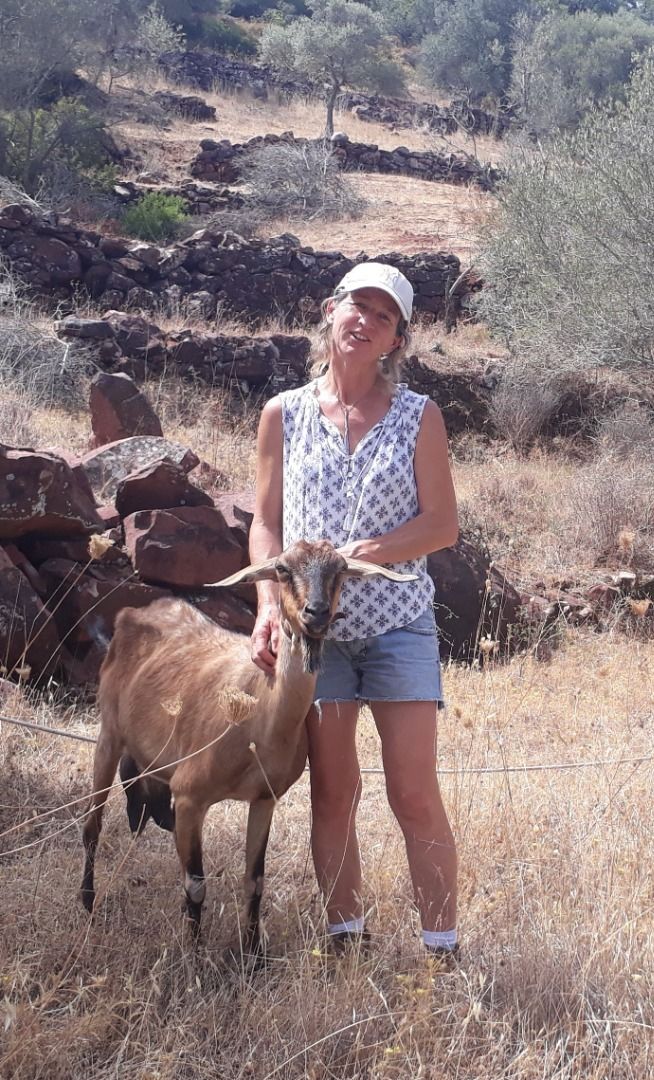“That is a VERY good deal”, I laughed, the brilliance of it slowly dawning on me as I watched a little billy goat gruff happily munching through a particularly vicious little yellow prickle (that had already pricked my ankle several times).
But I’m getting ahead of myself. Let me backtrack a little and, indeed, make my way ‘back up the track’ to the Terra Robinia homestead, near Messines, where I had come to meet Julia de Jesus Palma and also, rather excitingly, since I’ve always had a huge affinity for these rather mystical creatures, her goats.
The house is located next to an ancient burial site and so, it did make me wonder if I was in the right place. But Julia came out and invited me into their beautiful little house that reminded me, I guess because of the rocky nature of the walls in the kitchen, of a cosy cave.
Julia is German but has been here in Portugal since the 90s. Her husband, Felipe, is a somewhat wild and dashing tree surgeon, who I only saw briefly as he came in grinning after (I imagine) juggling chainsaws high up in a tree somewhere. They have two children. An eight year old girl called Stella and a four year old boy called Linus.
In a lot of the stories that I find for the Renature section, I’m being constantly told that the most important thing we can do to protect the future of the planet and fight against climate change is to plant trees.
Now, although this is undeniably true, Julia told me that this is a very long term solution as most trees take a lifetime to grow large enough to start to have a serious impact. This doesn’t, of course, mean that we shouldn’t sow any seeds for the future, but Julia is far more concerned and interested in a more immediate solution, namely: grass.
Everybody I’ve met has agreed that the ‘root’ of the problem in the fight against desertification (becoming a desert) is that we need more roots in the soil. Grasses grow a lot faster than trees and fulfil the vital function of keeping the ground entirely covered. This provides shade and keeps the ground cooler. This in turn creates more humidity and, as we all know, water is life. Grassland also gives all those important bugs and vital microorganisms a place to live and work. When land is cleared or rotavated every year and left bare and exposed through the long hot summer this is very bad for the soil (and its residents), not to mention how it reflects the sunlight back up and helps to heat up the planet even more.
But does this mean that we should just leave it and let the grass grow wild which could increase the risk of fire in the summer? Also no. In fact, Julia told me, grass wants to be managed and some grass left to its own devices will even grow so thick it suffocates itself and dies.
Grass actually appreciates having its head cut off from time to time.
Now, you could do this by working hard in the sun, sweat streaming off your back as you strim it, or, you could do what Julia does, which is employ a team of the finest land managers in the business: goats.
Well, that’s all very well you might be thinking. But don’t goats eat EVERYTHING? Well yes, they do (mostly). Unlike sheep that are ‘grazers’ and only enjoy grazing on soft green grass, goats, it amused me to find out, are what’s known as ‘browsers’. This means they are constantly browsing through everything and anything from your favourite (and spikiest) rose bush to your clothes left drying on the washing line.
They might even peruse the book you left next to the sunbed, or indeed, given the chance, happily gobble up this copy of The Portugal News (I would hope they find this article in particular, both informative and tasty).
But the key is to keep them where you want them. And Julia does this using a principle from something called Holistic Land Management. The idea is actually pretty simple. Since goats are fantastic for the land in short bursts (keeping the grass down, fertilizing the ground and generally stomping about and stirring things up) if left in one spot for too long will ‘overgraze’ and not give the plants time to recover. To avoid this, you simply put them in a portable fence (or tethered on a run) and just move them along every day or so.
Julia, Linus and I went for a little walk around the house, but before I met the goats, I was first introduced to the 20 or so chickens that are also very good for the land, as long as you don’t overdo it, and their coop is regularly moved too. A true testament to how well Julia’s method of land management is working is that even now, in August, when everything in the Algarve is golden brown and dry as a tinderbox, there’s still patches of green grass poking out in bits of her land.
Finally, we went around the back and made our way down a hill into a field where we found the goats. Julia has six at the moment. Madame Gazelle, Ruby, Blanca, Happy and two absolutely adorable young bucklings called Carabas and Boston.
They had been making their way down the hill being moved along every day or so, leaving the land well chomped and fertilized in their wake. A bit of this tree here, a bit of that bush there, helps to easily supplement their diets, and to get back to that ‘good deal’ that I mentioned at the beginning, they also eat all the horrible prickles and transform them into the most delicious goats milk. Julia says it is one of the most healthy things there is. Her children have been drinking it every day of their lives and they never get sick.
If you would like to find out more, Terra Robinia runs several different kinds of workshops, taught by either Julia or some of her friends, that include anything from holistic goat care, chicken keeping for beginners to beer brewing, soap making, using herbs for medicine and children’s days on the farm. Events normally happen in the morning followed by a nice lunch (and, if you’re lucky, her goat’s cheese will be on the menu).
Follow them on Facebook or email julia@terrarobinia.com so she can put you on her newsletter and you don’t miss anything.
















